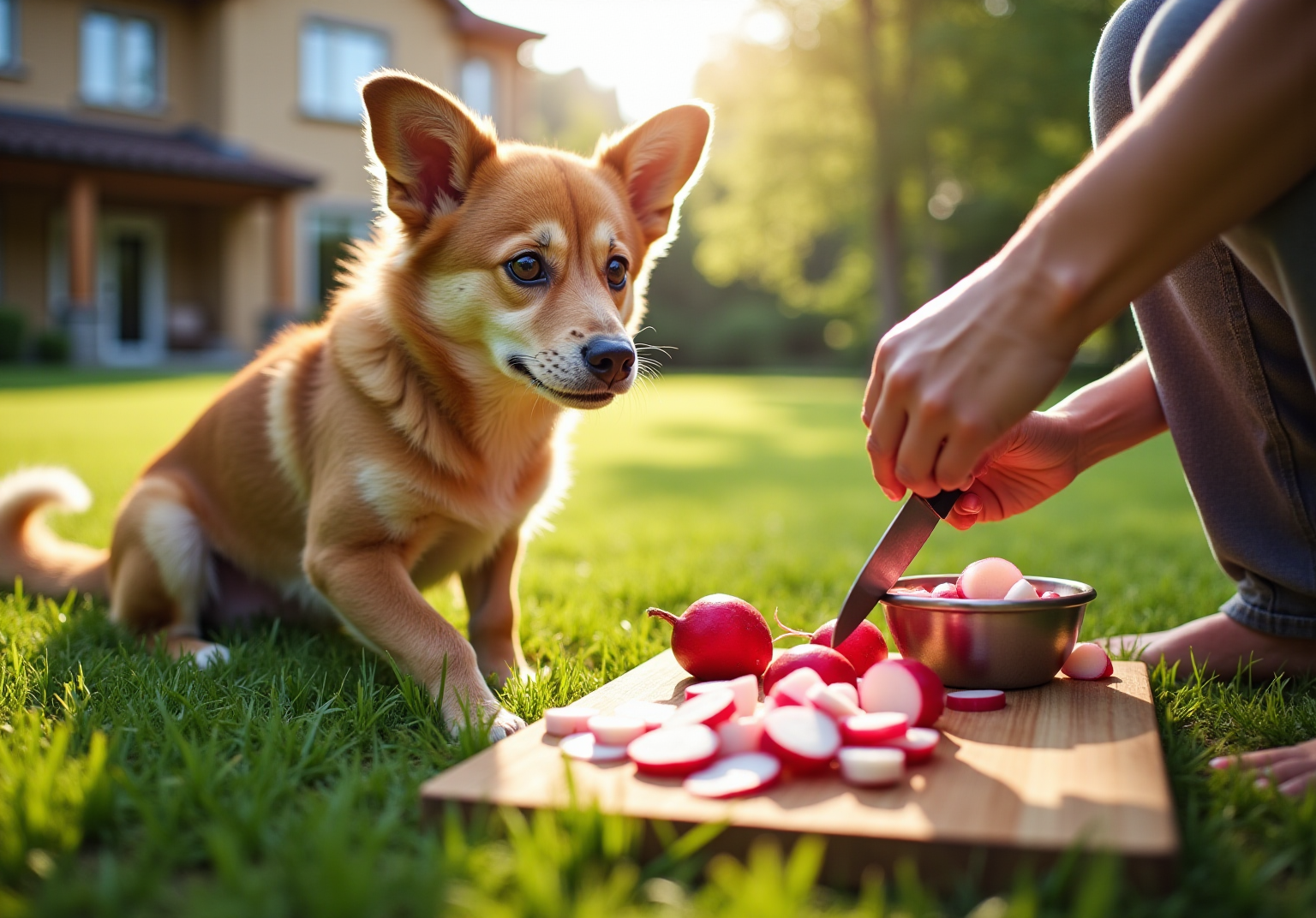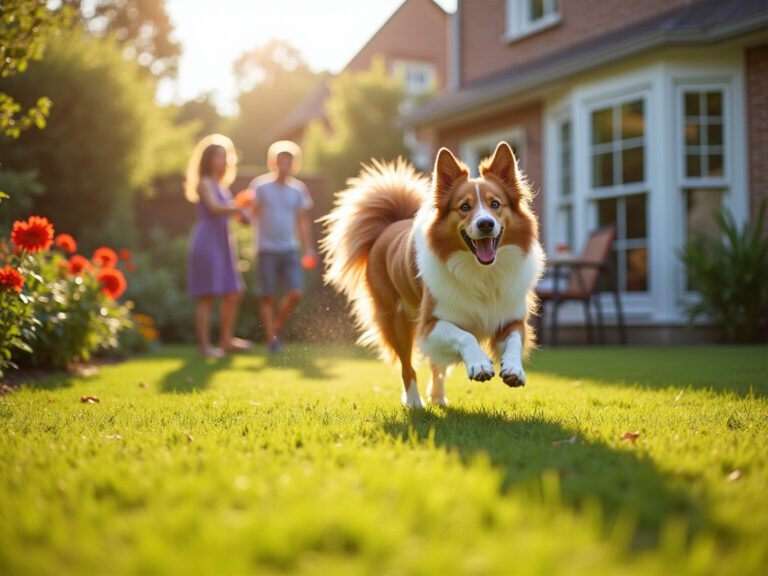Can Dogs Have Radishes? Assess Safety and Nutritional Benefits
Overview
As pet owners, we always want the best for our furry family members. Did you know that dogs can enjoy radishes as a safe and nutritious treat? When offered in moderation, radishes can provide essential benefits such as dietary fiber, potassium, and vitamin C.
However, it’s important to prepare them properly. Gradually introducing radishes into your dog’s diet is crucial, as is monitoring for any adverse reactions. This way, you can ensure that radishes contribute positively to your dog’s health without causing any digestive issues.
At Adventure Den, we understand your concerns about your pet’s diet, and we’re here to support you in nurturing a healthy lifestyle for your beloved companions. By being mindful of how you introduce new treats, you can create a loving and safe environment for your pets. So, why not give radishes a try? Your furry family members might just love them!
Introduction
Exploring new food options for your furry family members can be both exciting and daunting, especially when it comes to incorporating fresh vegetables into their diets. One question that often arises among pet owners is: can dogs safely enjoy radishes? These crunchy root vegetables not only provide a low-calorie treat but also deliver a wealth of vitamins and minerals that can enhance your dog’s health. However, the journey to safely introducing radishes into a canine diet does come with its challenges. How can you ensure that you are doing so without risking your beloved companion’s well-being? Let’s navigate this together.
Assess Radish Safety for Dogs
When offered in moderation, you may wonder, can dogs have radishes as a safe and nutritious addition to your furry family member’s diet? These non-toxic vegetables provide wonderful health benefits, including dietary fiber, potassium, and calcium, which support digestion and overall well-being. Both white and darker red roots are safe for dogs to consume, but it’s essential to provide only the root, as the leaves may cause gastrointestinal upset. Adequate preparation is key: wash the vegetables thoroughly to remove any pesticides or dirt, and cut them into manageable pieces to prevent choking hazards.
When introducing radishes, start with a small portion to assess your dog’s response. For instance:
- Small dogs (2-20 pounds) can be given a 1/4-inch cube.
- Larger breeds may enjoy up to three 1-inch cubes, depending on their size.
Observing your dog for any signs of distress is crucial; if any negative reactions arise, stop offering the vegetables and consult your veterinarian. As Dr. Jane Smith, a compassionate veterinarian, wisely notes, “Introducing new foods such as vegetables should be done gradually to ensure your dog tolerates them well.”
Veterinarians often recommend that treats should not exceed 10% of a dog’s daily caloric intake. Many devoted dog owners have successfully integrated root vegetables into their pets’ diets, often using them as a crunchy topping on meals or as a frozen treat. Radishes can be thinly sliced and frozen for a refreshing snack. However, it’s important to remember that excessive consumption of vegetables can lead to an upset stomach in our beloved canines, including whether can dogs have radishes. By following these nurturing guidelines, pet owners can safely explore the advantages of this delightful vegetable for their furry companions.
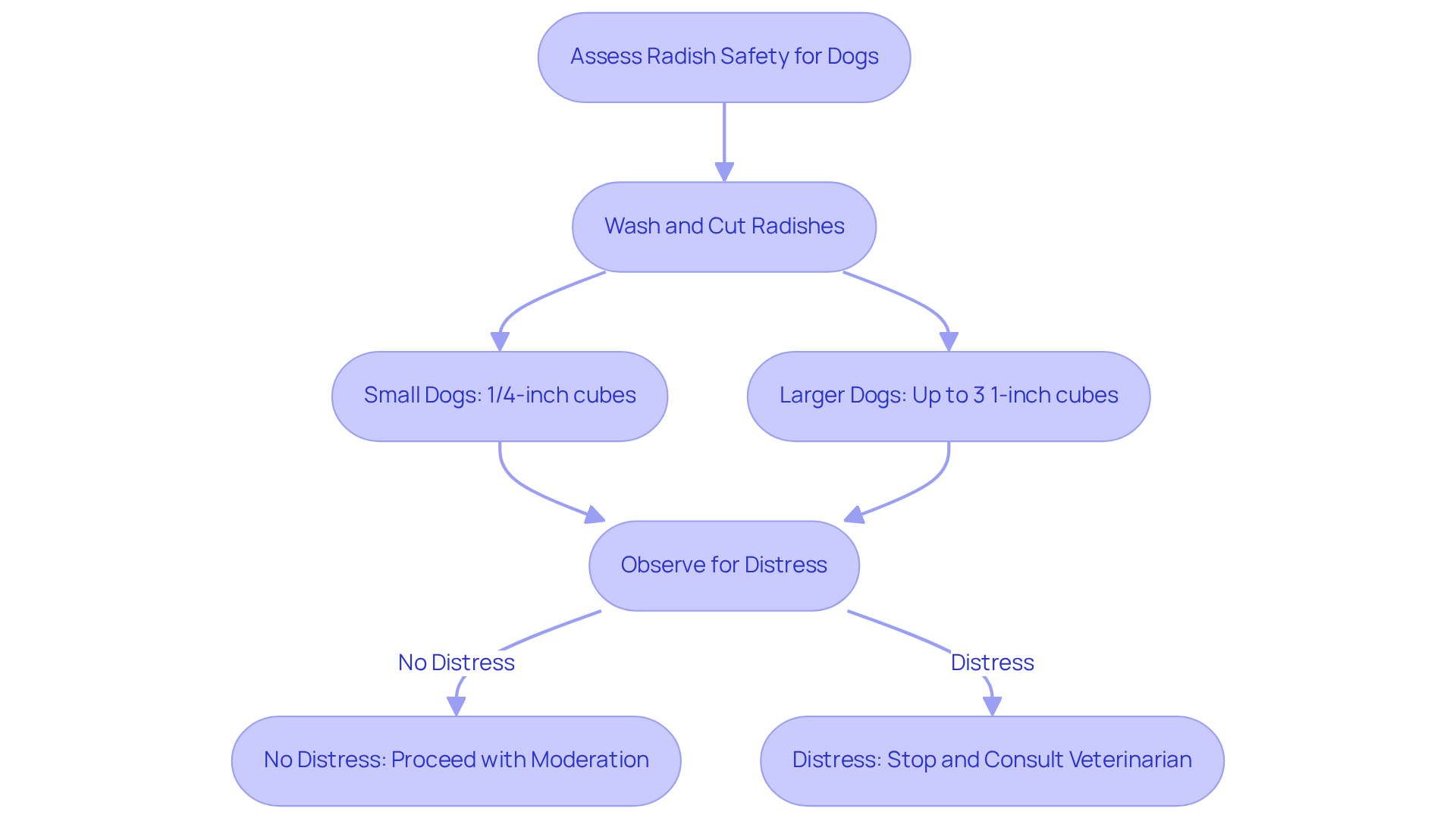
Understand Nutritional Benefits of Radishes
Radishes can be a delightful, low-calorie snack for your furry family members, so you might wonder, can dogs have radishes? With virtually no fat, they make an excellent choice for pets looking to maintain a healthy weight. Rich in essential nutrients like vitamin C, which supports the immune system, and potassium, vital for muscle function and heart health, these root vegetables are a wonderful addition to your pet’s diet. Plus, they provide dietary fiber that encourages healthy digestion and helps prevent constipation.
Their crunchy texture can also promote dental health by reducing plaque buildup. Dr. Sievert notes that if your dog is overweight or diabetic, you may ask, can dogs have radishes as a fantastic low-calorie option. However, it’s important to remember that these vegetables should only be offered as an occasional treat, making up no more than 10 percent of your dog’s daily caloric intake. This ensures that they do not replace a balanced diet.
When introducing radishes, be sure to wash them thoroughly and remove the greens, as these can cause gastrointestinal upset. Chopping them into small pieces can help avoid choking hazards. It’s always a good idea to introduce these vegetables gradually to see how your pet responds, as not all pets may enjoy their sharp flavor. For those who might be hesitant, white root vegetables are less peppery than their darker counterparts, making them a potentially better choice for some dogs. By incorporating radishes thoughtfully, you can nurture your pet’s health while providing a tasty treat they may love!
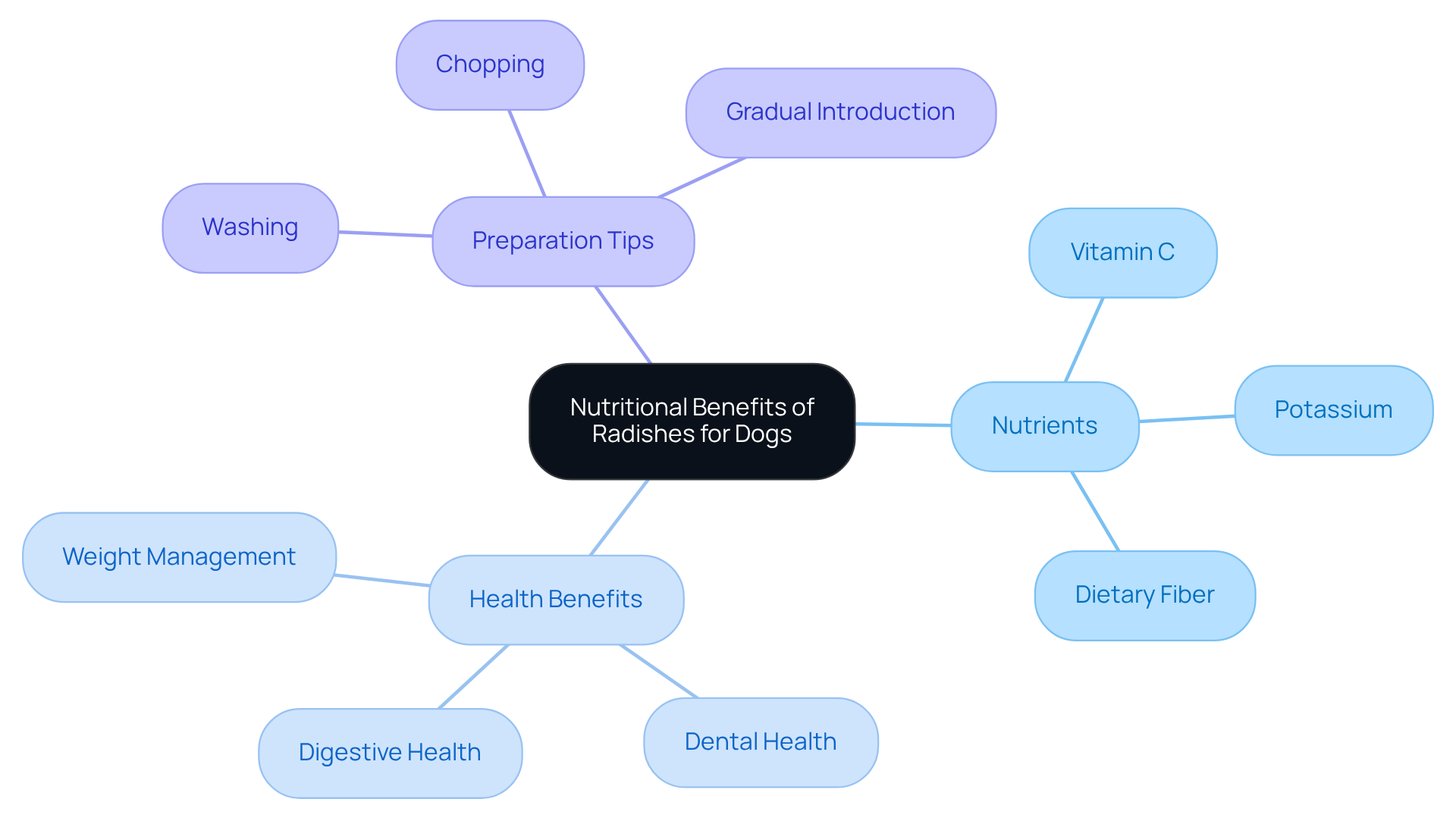
Prepare Radishes for Safe Serving
To safely prepare root vegetables for your furry family members, please follow these caring steps:
- Choose Fresh Vegetables: Opt for firm, blemish-free roots to ensure quality and health.
- Wash Thoroughly: Rinse the vegetables under cold water to remove dirt and possible pesticide residues, ensuring a safe treat.
- Remove the Greens: Discard the leaves, as they can lead to digestive upset, keeping your pet comfortable.
- Peel if Desired: While peeling is optional, it may aid digestion for some dogs, promoting their well-being.
- Cut into Small Pieces: Dice the vegetable into small, bite-sized pieces to mitigate choking risks, ensuring mealtime safety.
- Serve Plain: Offer the vegetable raw or lightly steamed, ensuring it is free from any seasonings or additives. Start with a small portion to monitor your dog’s reaction, fostering a nurturing environment.
Veterinary advice indicates that these vegetables should not make up more than 10% of a dog’s daily caloric consumption, and introducing them gradually is essential to prevent digestive problems. It’s also wise to consult a veterinarian before incorporating vegetables into your dog’s diet to understand any potential risks.
Many pet guardians have effectively included root vegetables into their pets’ meals, observing the advantages of enhanced digestion and hydration when prepared appropriately. For instance, a case study on the digestive advantages of certain vegetables emphasizes how moderate feeding can assist digestion. However, it is crucial to observe for any negative responses, as some pets may encounter digestive discomfort or allergic reactions.
Furthermore, these vegetables can be provided 2-3 times weekly at most, and both white and darker red varieties are safe for canines, with white ones being milder. Remember, your pet’s health and happiness are paramount, and with the right preparation, you can provide them with nutritious and delicious treats.
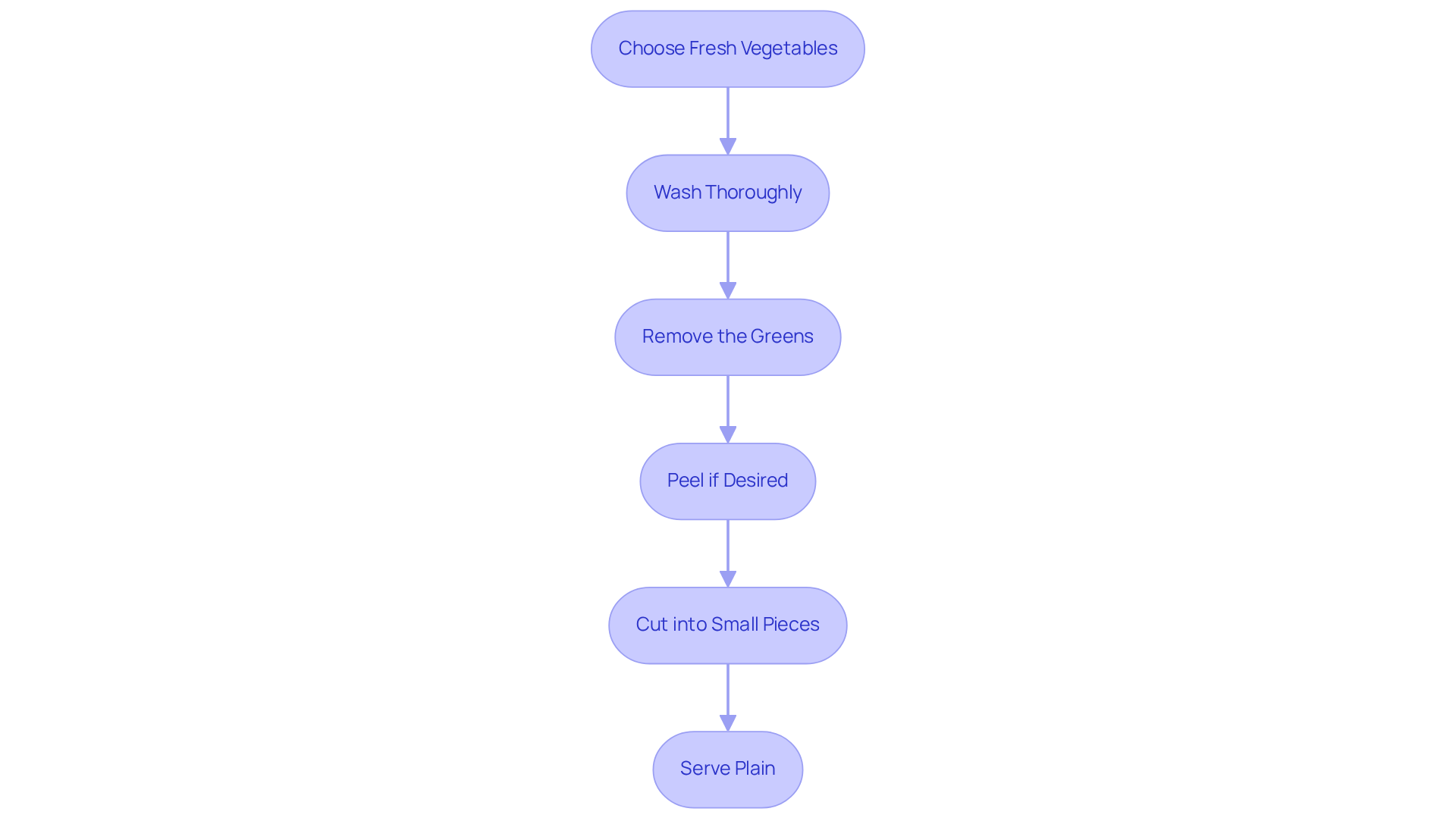
Identify Risks and Considerations
As a loving pet owner, you may wonder, can dogs have radishes, and about the safety of certain root vegetables for your furry family members. While these vegetables can be a delightful treat for many dogs, it’s essential to consider some important risks when wondering if can dogs have radishes. Overfeeding them may lead to digestive issues, such as gas, bloating, or diarrhea, primarily due to their high fiber content. To keep your pet happy and healthy, it’s advisable to limit these vegetables to 2-3 times per week, ensuring they do not exceed 10% of your dog’s daily caloric intake.
Interestingly, these vegetables can also support digestion by preventing constipation and diarrhea. However, be mindful that some dogs may have allergies to specific vegetables, which can result in symptoms like itching, swelling, skin irritations, or gastrointestinal distress. To minimize these risks, introduce the vegetables gradually and keep a close eye on your dog for any adverse reactions.
It’s crucial to avoid giving greens from the root vegetable, as they may cause more serious gastrointestinal problems. Always consult your veterinarian if you’re unsure about introducing new foods into your dog’s diet or if your dog shows any signs of discomfort or allergic reactions after eating. Remember, proper preparation is key; wash, peel, and cut radishes into small, bite-sized pieces to ensure safety, and consider whether can dogs have radishes. By taking these steps, you’re creating a nurturing environment for your beloved pet.
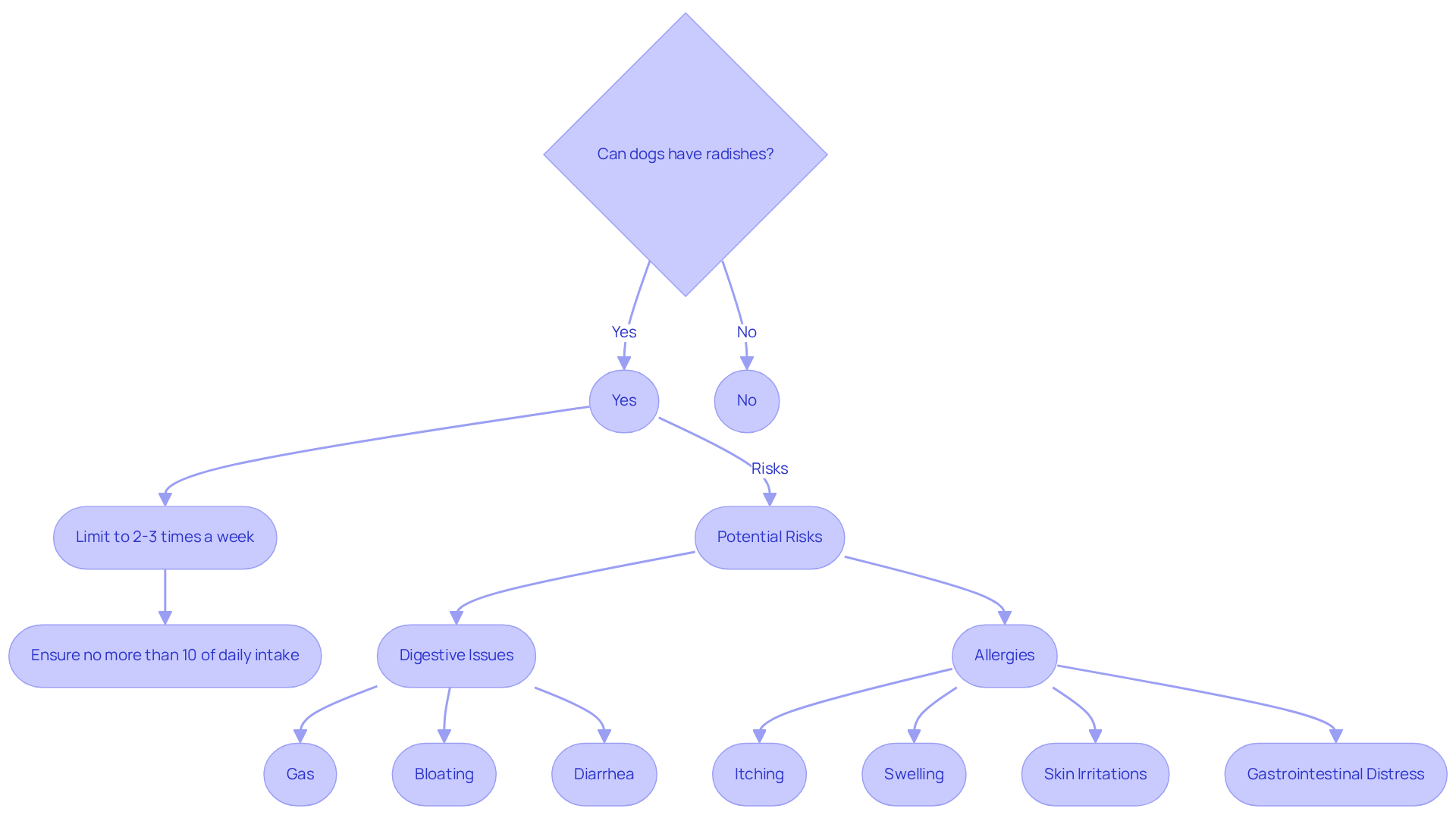
Conclusion
Introducing radishes into your dog’s diet can be a safe and nutritious choice when done correctly. These vibrant root vegetables offer a range of health benefits, including essential vitamins, minerals, and dietary fiber, which can enhance digestion and overall well-being. By understanding the proper ways to prepare and serve radishes, you can confidently incorporate this delicious treat into your furry family member’s meals.
Throughout this article, we’ve explored key insights, including the nutritional benefits of radishes, such as their low-calorie content and high levels of vitamin C and potassium. It’s important to remember that moderation is key; treats like radishes should not exceed 10% of your dog’s daily caloric intake to maintain a balanced diet. Additionally, careful preparation—washing, removing greens, and cutting into small pieces—is vital to ensure safety and prevent any digestive issues.
Ultimately, the decision to share radishes with your dog should be approached with care and consideration. By following the recommended guidelines and monitoring for any adverse reactions, you can provide a healthy, enjoyable snack that supports your dog’s health. Embracing a thoughtful approach to pet nutrition not only enhances their diet but also fosters a deeper bond between you and your beloved pet.
Frequently Asked Questions
Can dogs eat radishes?
Yes, dogs can eat radishes in moderation. They are non-toxic and provide health benefits such as dietary fiber, potassium, and calcium.
What parts of the radish are safe for dogs?
Only the radish root is safe for dogs to consume. The leaves may cause gastrointestinal upset.
How should radishes be prepared for dogs?
Radishes should be thoroughly washed to remove any pesticides or dirt and cut into manageable pieces to prevent choking hazards.
How much radish can I give my dog?
Small dogs (2-20 pounds) can be given a 1/4-inch cube of radish, while larger breeds may enjoy up to three 1-inch cubes, depending on their size.
What should I do when introducing radishes to my dog?
Start with a small portion to assess your dog’s response and observe for any signs of distress. If negative reactions occur, stop offering radishes and consult your veterinarian.
How often can I give my dog radishes?
Treats, including radishes, should not exceed 10% of a dog’s daily caloric intake.
Can radishes be used in different ways for dogs?
Yes, radishes can be used as a crunchy topping on meals or frozen into slices for a refreshing snack.
What happens if a dog eats too many radishes?
Excessive consumption of radishes can lead to an upset stomach in dogs. It’s important to offer them in moderation.

